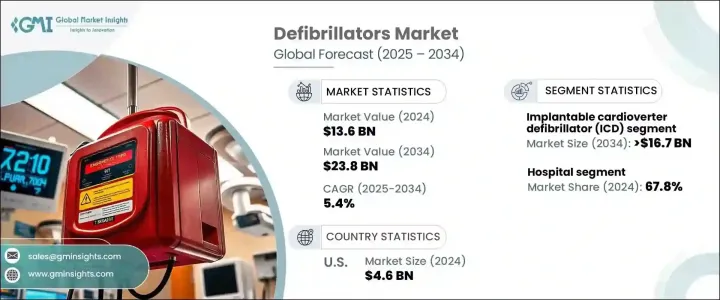PUBLISHER: Global Market Insights Inc. | PRODUCT CODE: 1684862

PUBLISHER: Global Market Insights Inc. | PRODUCT CODE: 1684862
Defibrillators Market Opportunity, Growth Drivers, Industry Trend Analysis, and Forecast 2025 - 2034
The Global Defibrillators Market is expected to reach USD 13.6 billion by 2024 and is projected to grow at a robust CAGR of 5.4% from 2025 to 2034. This steady growth is largely driven by the increasing prevalence of cardiovascular diseases, growing awareness of life-saving medical devices, and an aging population worldwide. As heart-related conditions remain one of the leading causes of death globally, the demand for defibrillators continues to rise. Additionally, advancements in technology, including the development of automated external defibrillators (AEDs) and implantable cardioverter defibrillators (ICDs), are making these life-saving devices more effective and user-friendly. AEDs, in particular, are increasingly seen as a crucial tool in public health initiatives, with more public spaces and medical facilities being equipped with these devices. This trend is also fueled by government policies and initiatives aimed at improving access to essential life-saving devices, ultimately enhancing response times to sudden cardiac arrest and other heart-related emergencies.

The defibrillators market is segmented based on product types, including implantable cardioverter defibrillators (ICDs) and external cardioverter defibrillators. ICDs designed to continuously monitor heart rhythms and deliver shocks when necessary to prevent sudden cardiac arrest, are projected to experience a CAGR of 5.2% over the forecast period. By 2034, this segment is expected to generate a market value of USD 16.7 billion. The widespread adoption of ICDs, particularly in high-risk patient populations and clinical settings, underscores their critical role in saving lives.
| Market Scope | |
|---|---|
| Start Year | 2024 |
| Forecast Year | 2025-2034 |
| Start Value | $13.6 Billion |
| Forecast Value | $23.8 Billion |
| CAGR | 5.4% |
In terms of end users, hospitals dominate the defibrillator market, holding a substantial share of 67.8% in 2024. Hospitals remain the primary settings for emergency and critical care, where advanced defibrillator devices are indispensable for swift response to cardiac emergencies. The availability of trained medical professionals further drives the adoption of defibrillators in these environments. Additionally, other healthcare facilities, such as ambulatory surgical centers, are increasingly investing in these life-saving technologies, contributing to the broader growth of the market.
In the U.S., the defibrillators market generated USD 4.6 billion in 2024 and is expected to grow at a CAGR of 4.5% through 2034. The U.S. benefits from a strong healthcare infrastructure, substantial investments in medical technologies, and supportive policies that encourage the widespread use of defibrillators. Public and private sector initiatives are driving the integration of AEDs into public spaces and healthcare facilities, ultimately improving survival rates by enhancing the speed and efficiency of emergency responses to sudden cardiac arrest.
Table of Contents
Chapter 1 Methodology and Scope
- 1.1 Market scope and definitions
- 1.2 Research design
- 1.2.1 Research approach
- 1.2.2 Data collection methods
- 1.3 Base estimates and calculations
- 1.3.1 Base year calculation
- 1.3.2 Key trends for market estimation
- 1.4 Forecast model
- 1.5 Primary research and validation
- 1.5.1 Primary sources
- 1.5.2 Data mining sources
Chapter 2 Executive Summary
- 2.1 Industry 3600 synopsis
Chapter 3 Industry Insights
- 3.1 Industry ecosystem analysis
- 3.2 Industry impact forces
- 3.2.1 Growth drivers
- 3.2.1.1 Rising prevalence of cardiac diseases
- 3.2.1.2 Technological advancements and introduction of innovative devices
- 3.2.1.3 Increasing public awareness
- 3.2.1.4 Increasing demand for wearable cardioverter defibrillators
- 3.2.2 Industry pitfalls and challenges
- 3.2.2.1 High cost of the devices
- 3.2.2.2 Product recall
- 3.2.1 Growth drivers
- 3.3 Growth potential analysis
- 3.4 Regulatory landscape
- 3.5 Pricing analysis, by region
- 3.5.1 North America
- 3.5.2 Europe
- 3.5.3 Asia Pacific
- 3.5.4 Latin America
- 3.5.5 MEA
- 3.6 Pipeline products
- 3.7 Startup scenario
- 3.8 Reimbursement scenario
- 3.9 Technology landscape
- 3.10 Gap analysis
- 3.11 Porter's analysis
- 3.12 PESTEL analysis
- 3.13 Indication landscape
- 3.13.1 Implantable cardioverter defibrillators (ICDs)
- 3.13.2 Wearable external cardioverter defibrillators (WCDs)
Chapter 4 Competitive Landscape, 2024
- 4.1 Introduction
- 4.2 Company matrix analysis
- 4.3 Company market share analysis
- 4.4 Competitive analysis of major market players
- 4.5 Competitive positioning matrix
- 4.6 Strategy dashboard
Chapter 5 Market Estimates and Forecast, By Product, 2021 - 2034 ($ Mn)
- 5.1 Key trends
- 5.2 Implantable cardioverter defibrillator (ICD)
- 5.2.1 Transvenous implantable cardioverter defibrillator
- 5.2.1.1 Dual-chamber ICDs
- 5.2.1.2 Single-chamber ICDs
- 5.2.2 Subcutaneous implantable cardioverter defibrillator
- 5.2.1 Transvenous implantable cardioverter defibrillator
- 5.3 External cardioverter defibrillator
- 5.3.1 Manual ED
- 5.3.2 Automated ED
- 5.3.2.1 Semi-automated external defibrillator
- 5.3.2.2 Fully automated external defibrillator
- 5.3.3 Wearable cardioverter defibrillator
Chapter 6 Market Estimates and Forecast, By End Use, 2021 - 2034 ($ Mn)
- 6.1 Key trends
- 6.2 Hospitals
- 6.3 Ambulatory surgical centers
- 6.4 Other end users
Chapter 7 Market Estimates and Forecast, By Region, 2021 - 2034 ($ Mn)
- 7.1 Key trends
- 7.2 North America
- 7.2.1 U.S.
- 7.2.2 Canada
- 7.3 Europe
- 7.3.1 Germany
- 7.3.2 UK
- 7.3.3 France
- 7.3.4 Spain
- 7.3.5 Italy
- 7.3.6 Netherlands
- 7.4 Asia Pacific
- 7.4.1 China
- 7.4.2 Japan
- 7.4.3 India
- 7.4.4 Australia
- 7.4.5 South Korea
- 7.5 Latin America
- 7.5.1 Brazil
- 7.5.2 Mexico
- 7.5.3 Argentina
- 7.6 Middle East and Africa
- 7.6.1 South Africa
- 7.6.2 Saudi Arabia
- 7.6.3 UAE
Chapter 8 Company Profiles
- 8.1 Abbott
- 8.2 Amiitalia
- 8.3 Asahi KASEI
- 8.4 BIOTRONIK
- 8.5 Boston Scientific
- 8.6 BPL Medical Technologies
- 8.7 CU MEDICAL
- 8.8 MEDITECH
- 8.9 Medtronic
- 8.10 MicroPort
- 8.11 mindray
- 8.12 NIHON KOHDEN
- 8.13 Philips
- 8.14 SCHILLER
- 8.15 Stryker




